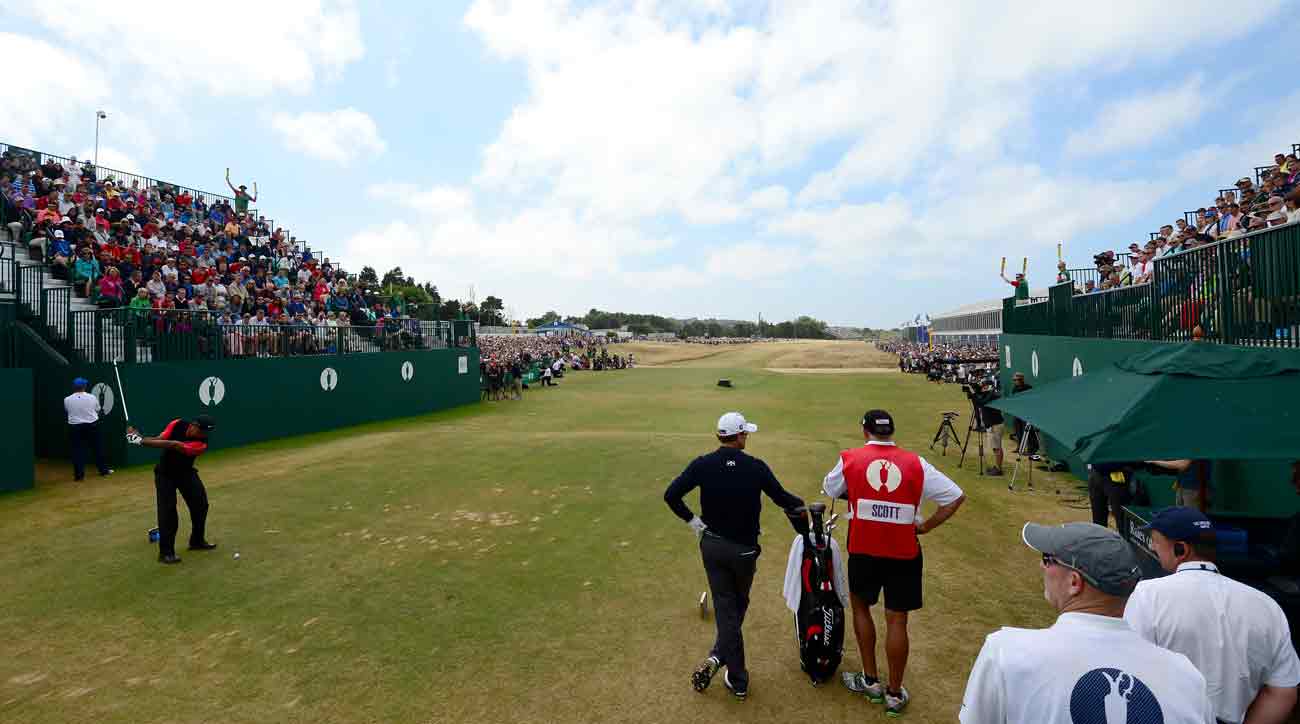With water looming left from tee to green and dense rough to the right, the first tee shot of the round at Le Golf National’s Albatros course is a nerve-wracking affair.

On this 419-yard par-4, there’s a sprinkler head at 290 yards in the middle of the fairway, which is an ideal spot. Yet, club selection is critical, because if you pull the drive, you’re wet. If the adrenaline is soaring and you flush it too far, by another 18 yards, you’re wet. Couple it with Ryder Cup pressure, including the biggest first tee grandstands ever seen, and we’re talking pure terror.
Is this the toughest start in Ryder Cup history? We’ll know in a few days. In the meantime, here are seven other nasty introductions to the Ryder Cup.
1. Muirfield, Gullane, Scotland; 450 yards, par 4 (Ryder Cup: 1973)
Masters and British Open champ Sandy Lyle, who played in five Ryder Cups, calls Muirfield’s opener, “the most difficult opening hole of any of the great Scottish links.”
A large, deep, C-shaped bunker hugs the left side of the landing area and gnarly rough edges the right side of the slender fairway. With OB further left, and a prevailing wind into your face, finding the landing area is a daunting task.
Lee Trevino, one of the straightest drivers ever, and who had just won the 1972 British Open at Muirfield, led off the Ryder Cup by driving it into the rough.

2. Royal Birkdale, Southport, England; 448 yards, par 4 (Ryder Cups: 1965, 1969)
A narrow fairway, punishing rough, a bunker left and OB right is havoc waiting to happen on a hole that three-time Ryder Cupper and Captain of the 2006 U.S. team Tom Lehman identifies as “one of the hardest opening holes in all of golf.”
The fact that the fairway bends left, around the bunker encourages the aggressive play, but amid all the pressure, it’s tough to let loose. In Ryder Cup days, this hole played as a 493-yard par-5, but the bunker, rough and wind still made it a tough tee shot.
3. Oak Hill (East), Rochester, N.Y.; 447 yards, par 4 (Ryder Cup: 1995)
After Ben Hogan lost the 1956 U.S. Open by one shot, he labeled the first hole at Oak Hill as the toughest opening hole he had ever faced.
At first glance, the drive doesn’t intimidate, its average-sized fairway bracketed by trees and rough, but the pressure comes from placement demands. Players must find the left side of the fairway, and be long enough to confront a brutal approach to a small green, guarded by trees, bunkers and a creek.
When Curtis Strange yanked his tee ball into the spinach on Saturday morning’s first Foursomes match, it began the downfall for the Yanks.

4. Celtic Manor (Twenty Ten), Newport, Wales; 465 yards, par 4 (Ryder Cup: 2010)
Colin Montgomerie, the European captain for the 2010 Ryder Cup match, described the hole as “a very challenging opener. Go left and a cluster of deep bunkers at the elbow of the dogleg left threatens to swallow the ball. Go right and face a tougher angle into the green.”
There’s added pressure to hit it long, because the green is framed with steep swales that will send the ball to a place well below the putting surface, so having a shorter approach is paramount.
When Dustin Johnson missed his drive to the right to open the proceedings, it was an early omen towards a U.S. defeat.
5. Muirfield Village, Dublin, Ohio; 470 yards, par 4 (Ryder Cup: 1987)
It’s unnerving enough to have to tee off in front of the U.S. team captain Jack Nicklaus, as it was in 1987 and even more so from the elevated tee at the course he built, knowing a tugged drive can find a creek that twists through the woods on the left. Push it right and a cluster of bunkers awaits on this dogleg-right hole.
Europe’s Howard Clark found the sand with his opening tee shot in ’87. He and partner Sam Torrance lost their foursomes clash to Curtis Strange and Tom Kite, but Europe laughed last, winning for the first time on U.S. soil, 15-13.

6. The K Club, Straffan, Co. Kildare, Ireland; 418 yards, par 4 (Ryder Cup: 2006)
U.S. team captain Tom Lehman tabbed this hole as “a great way to get a Ryder Cup underway. You can hit a 3-wood up the left side, short of the bunker, or take a driver on a more aggressive route, although you can’t hit it too far because a creek is waiting for longer hitters. The rough and the trees on the right mean you are pretty much dead if you go in there.”
And then there’s Tiger Woods, who pulled the Ryder Cup’s opening tee shot so far left it found a pond that wasn’t even considered in play.
7. Oakland Hills (South), Bloomfield Hills, Mich.; 436 yards, par 4 (Ryder Cup: 2004)
Robert Trent Jones Sr. reworked this Donald Ross Golden Ager ahead of the 1951 U.S. Open and transformed the first hole into an exercise in precision from the tee.
Its wasp-waisted, 25-yard-wide fairway is bracketed by three bunkers to the left and by a massive solo trap to the right. Ligament-snapping rough and a smattering a trees add further woe to the wayward hitter.
In 2004, the dream pairing of Tiger Woods and Phil Mickelson turned into a nightmare as they lost the first hole of the Ryder Cup to a red-hot Colin Montgomerie and Padraig Harrington on the way to a resounding loss for Tiger, Phil and eventually the U.S. squad.






